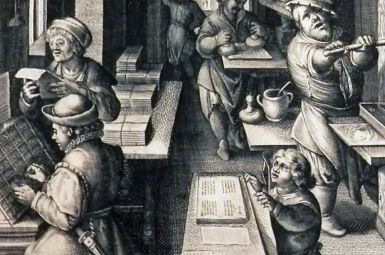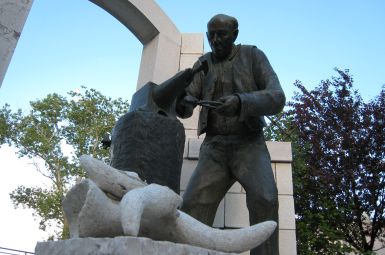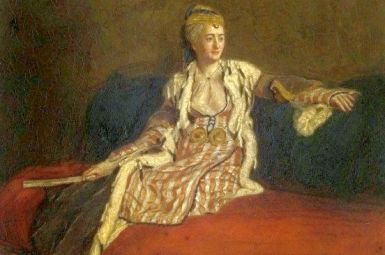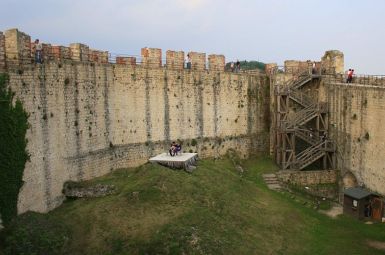
Il Borgo di Palmanova
La Stella Inespugnabile: Un Capolavoro Geometrico
La sua fama mondiale deriva dalla pianta unica a stella a nove punte, un disegno geometrico di straordinaria simmetria. Questa perfezione formale non è un mero esercizio di stile, ma il risultato di calcoli strategici per l’efficacia difensiva, dove ogni elemento rispondeva alla gittata dei cannoni del tempo.- Patrimonio UNESCO: Dal 2017, Palmanova fa parte del Patrimonio Mondiale UNESCO come parte del sito seriale transnazionale “Opere di difesa veneziane tra XVI e XVII secolo“, a conferma del suo valore storico e architettonico unico.
- Le Tre Cerchie: La città si sviluppa su tre cerchie di fortificazioni distinte (del XVI, XVII e XIX secolo), complete di bastioni, fossati, rivellini e gallerie sotterranee. Queste ultime, le Gallerie di Contromina, offrono oggi un percorso immersivo per esplorare il complesso e ingegnoso sistema difensivo.
- Le Porte Monumentali: L’ingresso è garantito da tre magnifiche e imponenti porte in pietra – Porta Udine, Porta Cividale e Porta Aquileia – che accolgono il visitatore in un viaggio nel tempo.
Piazza Grande: Il Cuore della Città Ideale
Al centro esatto della fortezza si trova Piazza Grande, un’ampia e scenografica piazza d’armi di forma esagonale, da cui si diramano, con perfetta coerenza urbanistica, le strade che conducono ai bastioni.- Il Duomo Dogale: La piazza è dominata dal Duomo del Santissimo Redentore, eretto tra il 1615 e il 1636. La sua facciata in pietra bianca d’Istria e grigia d’Aurisina, con il caratteristico campanile deliberatamente basso (per non esporlo ai colpi nemici), è un esempio di architettura veneta con influenze palladiane. All’interno si custodiscono preziose opere, tra cui la Pala delle Milizie del Padovanino.
- Simboli di Potere: Il centro della piazza è marcato dall’alto Stendardo e dalle undici statue che rappresentano i Provveditori Generali più meritevoli che governarono la fortezza in nome della Serenissima.

Il Borgo d’Italia
tutto da scoprire ed esplorare
Monumenti
Palmanova: La Stella di Pietra e il Capolavoro dell’Architettura Militare
Palmanova non è semplicemente una città, è un’opera d’arte ingegneristica e urbanistica unica al mondo. Dichiarata Monumento Nazionale nel 1960 e inserita nel 2017 nella lista del Patrimonio Mondiale UNESCO come parte delle “Opere di difesa veneziane tra il XVI e il XVII secolo”, questa fortezza è la più perfetta incarnazione della “Città Ideale” del Rinascimento.
I suoi monumenti non sono singoli edifici, ma componenti essenziali di un sistema difensivo e abitativo concepito per la massima funzionalità e simmetria.
Il Sistema Fortificato: Geometria Perfetta
La vera meraviglia monumentale di Palmanova è la sua struttura stessa: una stella a nove punte perfettamente geometrica.
- Le Tre Cerchie Difensive: La fortezza fu costruita dalla Repubblica di Venezia a partire dal 1593. Le sue difese sono disposte su tre anelli concentrici: la prima cerchia, veneziana, con nove baluardi a freccia; la seconda, aggiunta sempre dai veneziani, con i rivellini che proteggono le cortine (i lati del poligono); e la terza, aggiunta da Napoleone, con le lunette esterne.
- Le Gallerie di Contromina: Nel cuore delle fortificazioni si snoda una fitta rete di gallerie sotterranee, chiamate “Gallerie di Contromina”. Questi suggestivi percorsi erano progettati per consentire alle milizie di spostarsi inosservate o per minare le posizioni del nemico, offrendo oggi un’esperienza immersiva nella strategia militare del passato.
Il Cuore Civico e Religioso: Piazza Grande
Al centro esatto della fortezza, dove convergono sei assi viari radiali, si apre la Piazza Grande, un esagono perfetto, un tempo Campo di Marte per le adunate e le esercitazioni militari.
- Lo Stendardo: Al centro della Piazza sorge l’alto pennone chiamato Stendardo, che simboleggia il potere della fortezza e, nel corso della storia, ha innalzato i vessilli di Venezia, della Francia, dell’Austria e, infine, dell’Italia.
- Il Duomo Dogale: Affacciato sulla Piazza, il Duomo del Santissimo Redentore (o Duomo Dogale) è il principale edificio religioso. Edificato tra il 1615 e il 1636, si distingue per la sua facciata in pietra bianca e grigia e, soprattutto, per il suo campanile volutamente ribassato. Questa singolare caratteristica architettonica fu dettata da esigenze strategiche: evitare che la torre campanaria potesse offrire un punto di riferimento o un bersaglio all’artiglieria nemica, confermando come a Palmanova anche il sacro fosse subordinato alla difesa.
- I Provveditori: La piazza è circondata da undici statue dei Provveditori Generali della Fortezza, che ricordano gli uomini inviati da Venezia per governare la città militare.
Le Porte Monumentali: Accessi Fortificati
Gli unici tre accessi alla città sono le magnifiche Porte Monumentali, vere e proprie opere d’architettura fortificata che bucano la prima cinta muraria.
- Porta Udine, Porta Cividale e Porta Aquileia: Ciascuna porta, attribuita all’architetto Vincenzo Scamozzi, si affaccia verso le rispettive città. La loro facciata esterna è rivestita in bugnato e presenta un aspetto imponente e solenne.
- Difesa e Funzionalità: Oltre alla bellezza estetica, le porte erano macchine da guerra: dotate di ponti levatoi, rastrelli e ambienti per la guardia e per il Contestabile di Sanità (l’ufficiale medico), garantivano il controllo totale su chi entrava e usciva dalla fortezza. Porta Cividale, in particolare, ospita oggi il Museo Storico Militare, che permette di esplorare gli ambienti di guardia originali.
Palmanova è un viaggio nel tempo e nella ragione, dove ogni pietra e ogni angolo della sua geometria racconta l’ambizione di un’epoca che cercava la perfezione nella difesa e nell’ordine.
Curiosità
Palmanova: La Città-Stella e i Segreti del Perfetto Ordine Militare
Palmanova non è solo un monumento: è una meraviglia ingegneristica, una dichiarazione di intenti urbanistica e una fortezza che sfida il tempo. Costruita dalla Repubblica di Venezia a partire dal 1593, questa “Città Ideale” a forma di stella a nove punte custodisce curiosità che vanno ben oltre la sua perfetta geometria militare, svelando un’ossessione per l’ordine e la difesa.
L’Ossessione per la Geometria e il Numero Nove
La curiosità più evidente di Palmanova è, ovviamente, la sua forma, ma i dettagli della sua costruzione rivelano una precisione quasi maniacale.
- La Nascita Misteriosa (e Perfetta): Palmanova fu fondata il 7 ottobre 1593, giorno in cui ricorreva l’anniversario della vittoria cristiana di Lepanto (1571) e la festa di Santa Giustina, patrona di Padova. Questa data non fu casuale, ma un auspicio per la nuova fortezza. La sua pianta è un’esemplare stella a nove punte, risultato di calcoli matematici complessi e della tecnologia militare più avanzata dell’epoca. Il numero nove non è casuale: simboleggia i baluardi, i lati (cortine) e i raggi viari che conducono al centro.
- La Città Senza Piazze Nascoste: L’intera Palmanova è stata progettata per avere un solo e unico centro focale: la Piazza Grande, un esagono perfetto. A differenza di molte città medievali, che nascondevano le piazze per ragioni difensive, qui non esistono slarghi o piazzette secondarie. Ogni strada radiale conduce direttamente al cuore della fortezza, assicurando la rapidità di movimento delle truppe e la visibilità totale.
Dettagli Curiosi di Vita Quotidiana e Difesa
Anche gli elementi che sembrano banali nella fortezza nascondono ragioni militari e storie affascinanti.
- Il Mistero del Campanile Basso: Il Duomo Dogale, che domina Piazza Grande, ha un campanile di altezza insolitamente ridotta. La spiegazione non è architettonica, ma puramente difensiva: un campanile più alto avrebbe fornito un punto di riferimento troppo comodo e un bersaglio perfetto per l’artiglieria nemica che assediava la città. In Palmanova, l’estetica cedeva il passo alla sopravvivenza.
- Le Porte e il Controllo Sanitario: Le tre Porte Monumentali (Porta Udine, Porta Cividale, Porta Aquileia) erano l’unico accesso alla città. Oltre a ospitare soldati di guardia e ponti levatoi, includevano gli alloggi del Contestabile di Sanità. Questa figura era l’ufficiale medico che aveva il compito di ispezionare tutti coloro che entravano in città, un sistema di quarantena e controllo sanitario sorprendentemente moderno per prevenire la diffusione di epidemie all’interno della fortezza.
- Il Segreto Sotto i Bastioni: Sotto i massicci bastioni, a Palmanova si sviluppa un intricato labirinto di passaggi chiamati Gallerie di Contromina. Questi tunnel sotterranei, lunghi centinaia di metri, erano l’arma segreta della fortezza: servivano a spiare il nemico che tentava di avvicinarsi scavando gallerie (le mine) per far crollare le mura. I difensori ascoltavano i rumori e, se necessario, riempivano le gallerie nemiche di fumo, acqua o le facevano crollare.
Dal Disegno Utopico al Patrimonio Mondiale
La storia moderna di Palmanova ne ha confermato l’unicità, trasformando l’antica macchina da guerra in un bene culturale.
- Una Città Inabitata: Nonostante il suo design perfetto, Palmanova rimase in gran parte spopolata per oltre un secolo dalla sua fondazione, tanto che Venezia fu costretta a offrire terre e benefici per attirare coloni. L’utopia militare stentò a decollare come centro abitato.
- Patrimonio UNESCO: Oggi, Palmanova è riconosciuta a livello mondiale per il suo valore eccezionale. È entrata nel Patrimonio Mondiale UNESCO nel 2017 come parte delle “Opere di difesa veneziane tra il XVI e il XVII secolo”, certificando il suo ruolo di modello insuperabile di architettura militare. Passeggiare sui suoi bastioni significa percorrere un manuale di ingegneria a cielo aperto.
Personaggi
Palmanova: La Città Fortezza e i suoi Figli Illustri
Sebbene Palmanova sia celebre in tutto il mondo come capolavoro dell’architettura militare, la “Città Ideale” ha saputo anche generare personalità che, pur in numero limitato data la sua vocazione strategica, hanno lasciato un segno nel panorama culturale e scientifico. I suoi figli più illustri riflettono l’intreccio unico di storia, scienza e tradizione che definisce la fortezza.
Menti Scientifiche e Giuridiche
La precisione matematica che ha plasmato Palmanova sembra aver ispirato le menti dei suoi nativi a eccellere nelle discipline rigorose.
- Pietro Zorutti (1792 – 1867): Figura di spicco del panorama letterario friulano, Zorutti è considerato uno dei massimi esponenti della poesia in lingua friulana del XIX secolo. Sebbene Palmanova sia nota per la sua storia militare, Zorutti ha contribuito in modo fondamentale a preservare e celebrare l’identità linguistica e culturale friulana. La sua opera più celebre, le raccolte di “Poesie” e in particolare la “Strofe”, è intrisa di un profondo sentimento per la sua terra, offrendo una prospettiva lirica sulla vita nella fortezza e nel Friuli.
- Contardo Ferrini (1859 – 1902): Sebbene la sua vita sia strettamente associata a Milano e Pavia, il legame con Palmanova è cruciale. La famiglia Ferrini era originaria della fortezza. Contardo è stato un eminente giurista e accademico, professore di Diritto Romano, la cui figura è oggi venerata come Beato dalla Chiesa Cattolica. Il suo rigore scientifico e la sua profonda spiritualità lo rendono un esempio di armonia tra scienza e fede, un tratto che, seppur indirettamente, rispecchia l’ordine e la disciplina intrinseci alla città di fondazione.
Figure del Novecento e della Tradizione Militare
La storia contemporanea ha visto Palmanova dare i natali a personalità legate al mondo delle istituzioni e dell’arte.
- Vincenzo Scussa (1777 – 1877): Uno dei più noti patrioti e letterati palmarini del XIX secolo. La sua vita attraversò le epoche cruciali delle dominazioni napoleonica e asburgica. Fu un avvocato e un politico attivo, ma è ricordato soprattutto per la sua intensa attività letteraria e storiografica. Scussa contribuì a mantenere vivo lo spirito civico e l’identità locale durante i turbolenti anni delle guerre d’indipendenza, rappresentando la coscienza storica della città.
- Vittorio Rossi (1864 – 1926): Critico letterario e filologo di fama, Rossi fu docente all’Università di Padova e membro dell’Accademia dei Lincei. Le sue opere, in particolare sulla letteratura italiana del Rinascimento, sono considerate fondamentali per lo studio della critica testuale e della storia letteraria. Rossi è l’esempio di come la “Città Ideale” abbia favorito l’eccellenza nelle discipline umanistiche, portando la precisione e l’analisi tipiche dell’ingegneria al servizio della critica.
Questi individui, dalle cime della poesia friulana alle aule di Diritto Romano, attestano che Palmanova è più di una geometria perfetta: è una fucina di menti che hanno saputo interpretare e celebrare il suo spirito unico.
Ricette Tipiche
L’Arte Culinaria di Palmanova: Sapori di Fortezza e Tradizione Friulana
Palmanova, la “Città Ideale” a forma di stella, traduce la sua robusta identità storica in una cucina che è l’espressione più autentica del Friuli di pianura e della tradizione agricola. Le ricette qui sono piatti “di sostanza”, pensati per dare energia ai soldati e nutrimento alle genti di confine. L’enogastronomia palmarina è un inno alla qualità dei prodotti locali, dove formaggio, maiale e sapori intensi dominano la scena.
Il Piatto Simbolo: Il Frico
Il Frico è l’icona gastronomica friulana, e nella tavola di Palmanova non può mancare. Nato come ricetta di recupero, è oggi elevato a capolavoro della cucina povera.
- L’Essenza: Si tratta di una preparazione a base di Formaggio Montasio (spesso di diverse stagionature per bilanciare morbidezza e sapore) fuso in padella.
- Le Varianti: A Palmanova e nella zona circostante si predilige il Frico Morbido, arricchito dall’aggiunta di patate lessate e schiacciate o da cipolle stufate. Il risultato è un tortino dorato all’esterno e fondente all’interno, robusto e cremoso.
- L’Abbinamento Perfetto: Il Frico viene rigorosamente servito caldo, accompagnato da una fetta di fumante Polenta, creando l’accoppiata perfetta che definisce la convivialità friulana.
Il Classico Invernale: Musèt e Brovada
Questo è il piatto che riscalda le fredde sere invernali e incarna il gusto deciso della tradizione contadina e di macellazione del maiale.
- Il Musèt: È la variante friulana del cotechino o zampone, un insaccato preparato con i tagli meno nobili della testa del maiale (il “muso”, appunto). Viene bollito a lungo e servito a fette.
- La Brovada (o Brovade): Questo contorno è un’eccellenza DOP unica. Si tratta di rape bianche lasciate macerare nelle vinacce d’uva (i residui della spremitura) per quaranta giorni. Le rape, grattugiate e poi stufate con lardo, aglio e alloro, acquistano un inconfondibile sapore acidulo e aromatico, che bilancia perfettamente la grassezza del musèt.
- Un Equilibrio di Sapori: La brovada, con la sua nota agrodolce e leggermente fermentata, bilancia la ricchezza del musèt, offrendo un’armonia di sapori complessa e appagante.
Altri Tesori della Tavola Palmarina
La posizione strategica di Palmanova le consente di attingere alle eccellenze regionali, portandole al centro della propria offerta gastronomica.
- Salumi e Affumicati: La vicinanza a zone di eccellenza nel campo della salumeria fa sì che in ogni osteria si possano gustare il pregiato Prosciutto di San Daniele o i salumi tipici, come il saporito Salame nell’Aceto (Salàm tal ašêt), una preparazione a base di salame fresco cotto con cipolla e aceto.
- I Sapori del Mare e della Terra: Nonostante l’entroterra, la vicinanza alla costa permette di gustare anche piatti di pesce, spesso serviti con la polenta. In alternativa, si trovano i robusti Primi Piatti della tradizione friulana, come i Risotti conditi con i prodotti dell’orto (ad esempio, gli asparagi) o i Cjarsons, ravioli ripieni di Carnia che hanno ormai conquistato anche la pianura.
- Vini di Carattere: A Palmanova, il pasto è sempre accompagnato da un taj (bicchiere di vino) robusto. Vini rossi come il Refosco dal Peduncolo Rosso o il Cabernet Franc sono l’abbinamento ideale per frico e musèt, mentre i bianchi aromatici come il Friulano (ex Tocai) e il Pinot Grigio onorano l’eccellenza enologica del Friuli.


